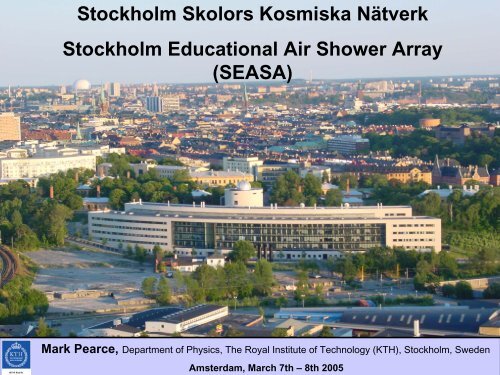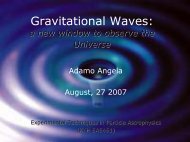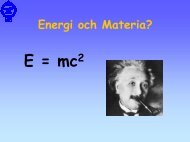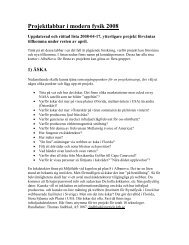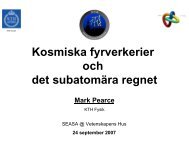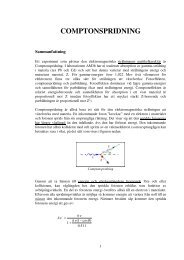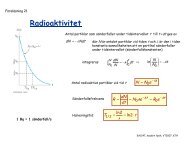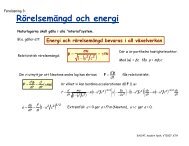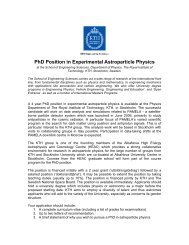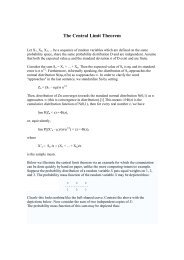Stockholm Skolors Kosmiska Nätverk Stockholm Educational Air ...
Stockholm Skolors Kosmiska Nätverk Stockholm Educational Air ...
Stockholm Skolors Kosmiska Nätverk Stockholm Educational Air ...
Create successful ePaper yourself
Turn your PDF publications into a flip-book with our unique Google optimized e-Paper software.
<strong>Stockholm</strong> <strong>Skolors</strong> <strong>Kosmiska</strong> Nätverk<br />
<strong>Stockholm</strong> <strong>Educational</strong> <strong>Air</strong> Shower Array<br />
(SEASA)<br />
Mark Pearce - KTH <strong>Stockholm</strong> -<br />
Mark Pearce, Department of Physics, The Royal Institute of Technology (KTH), <strong>Stockholm</strong>, Sweden<br />
Amsterdam, March 7th – 8th 2005
<strong>Stockholm</strong> <strong>Skolors</strong> <strong>Kosmiska</strong> Nätverk<br />
<strong>Stockholm</strong> <strong>Educational</strong> <strong>Air</strong> Shower Array<br />
(SEASA)<br />
Part 1: Introduction<br />
Part 2: Technical details<br />
Mark Pearce - KTH <strong>Stockholm</strong> -<br />
Mark Pearce, Department of Physics, The Royal Institute of Technology (KTH), <strong>Stockholm</strong>, Sweden<br />
Amsterdam, March 7th – 8th 2005
Orientation<br />
• KTH particle physics group<br />
– Astroparticle physics with balloons and satellites (PAMELA, GLAST)<br />
– Accelerator-based particle physics (ATLAS, D0)<br />
• Mark Pearce, lecturer (pearce@particle.kth.se)<br />
• Stefan Rydström, engineer<br />
• Petter Hofverberg, PhD student<br />
Mark Pearce - KTH <strong>Stockholm</strong> -<br />
• ... and usually 1-2 final year undergraduate students (very<br />
important!). Four have written theses (20 weeks) so far. 2<br />
currently on-going.<br />
• Financing: none, (direct at least)
Mark Pearce - KTH <strong>Stockholm</strong> -<br />
10 15 eV<br />
10 17 eV<br />
10 19 eV<br />
5 km
Photo: P. Walck<br />
Mark Pearce - KTH <strong>Stockholm</strong> -
~1 m<br />
• ’NE’ scintillator recycled from CP-<br />
LEAR<br />
• Wavelength shifter read-out<br />
• Hamamatsu R5900U PMTs<br />
(spares from PAMELA)<br />
• All of these will be changed in<br />
next phase...<br />
13 cm<br />
Mark Pearce - KTH <strong>Stockholm</strong> -<br />
• Car roof boxes used to provide<br />
cheap and weatherproof<br />
housing<br />
• No temperature control
Per station:<br />
• 3 x scintillators + PMTs / HV<br />
• Programmable analogue front-end<br />
• Programmable logic array<br />
• GPS timing (PPS+100MHz+sawtooth)<br />
• Embedded Linux ’DAQ on a chip’<br />
• Environmental sensors (Temp. etc.)<br />
Server (at AlbaNova)<br />
• MySQL database (Linux / Java)<br />
Mark Pearce - KTH <strong>Stockholm</strong> -<br />
Viewer (web browser – where ever..)<br />
• Client-side Java applet
Web Viewer: ’Live Live’ Map<br />
Mark Pearce - KTH <strong>Stockholm</strong> -
Web Viewer: Monitoring<br />
Mark Pearce - KTH <strong>Stockholm</strong> -
Web Viewer: Administrator<br />
Mark Pearce - KTH <strong>Stockholm</strong> -
Present Status<br />
• Two stations running at AlbaNova University Centre<br />
• Proof-of-principle studies complete for basic design<br />
• Now in production stage for first cluster of stations<br />
• Showers seen! (~35 / hour / station; ~10 / day / both stations)<br />
• Many studies: Temperature, pressure effects. GPS position<br />
fixing and timing. <strong>Air</strong>es simulations. Detector spacing,<br />
threshold settings etc. etc.<br />
Mark Pearce - KTH <strong>Stockholm</strong> -<br />
• Learnt many lessons during installation!<br />
– Weatherproofing detectors and securing against wind<br />
– Cabling
Two-station Showers!<br />
[120 hours / 78 triggers / 33 within 1 µs]<br />
Mark Pearce - KTH <strong>Stockholm</strong> -<br />
[Random coincidences]
Mark Pearce - KTH <strong>Stockholm</strong> -<br />
Education / Outreach<br />
• Contact established with 3 local ’gymnasium’ schools (pre-university)<br />
• Aim to involve students in detector construction, installation, testing, soldering<br />
electronics boards etc.<br />
• Web software allows students to monitor their station and access data<br />
• Cosmic ray telescope is an important bridging tool<br />
• Starting this programme is an important milestone for 2005<br />
[Brochure]
Future Plans<br />
• Scintillators / PMTs ordered for another 5 stations<br />
which will be deployed during 2005 (at least four of<br />
these at schools)<br />
– Single sheets of scintillator (1m x 30 cm x 1.5 cm) remove the<br />
need for (expensive!) wavelength shifting read out<br />
– Hamamatsu R5900U PMTs replaced with the much cheaper<br />
Hamamatsu R6094 (Ø 28 mm) / Photonis XP3314 (Ø 76 mm)<br />
– Electronics design fixed, but firmware will be updated<br />
– Viewer software will evolve (more features!)<br />
– Electronics will be packaged more attractively<br />
Mark Pearce - KTH <strong>Stockholm</strong> -<br />
• Lack of funding is a major hinder to subsequent<br />
expansion – significant additional funding will also be<br />
sought in 2005
Mark Pearce - KTH <strong>Stockholm</strong> -
<strong>Stockholm</strong> <strong>Skolors</strong> <strong>Kosmiska</strong> Nätverk<br />
<strong>Stockholm</strong> <strong>Educational</strong> <strong>Air</strong> Shower Array<br />
(SEASA)<br />
Part 1: Introduction<br />
Part 2: Technical details<br />
Mark Pearce - KTH <strong>Stockholm</strong> -<br />
Mark Pearce, Department of Physics, The Royal Institute of Technology (KTH), <strong>Stockholm</strong>, Sweden<br />
Amsterdam, March 7th – 8th 2005
Now<br />
• ’NE’ scintillator recycled from CP-LEAR<br />
• Wavelength shifter read-out<br />
• Hamamatsu R5900U PMTs<br />
Future<br />
Mark Pearce - KTH <strong>Stockholm</strong> -<br />
• Single sheets of scintillator (1m x 30 cm x<br />
1.5 cm) remove the need for (expensive!)<br />
wavelength shifting read out<br />
• Hamamatsu R5900U PMTs replaced with<br />
the much cheaper Hamamatsu R6094 (Ø<br />
28 mm) / Photonis XP3314 (Ø 76 mm)
School 1<br />
PPS<br />
GPS<br />
RS232<br />
Internet<br />
t 1<br />
Analog<br />
front-end<br />
t 2<br />
t 3<br />
Programmable<br />
Logic Array<br />
RS232<br />
Single Chip<br />
Computer<br />
(Linux)<br />
Analog<br />
Digital<br />
School 2<br />
Mark Pearce - KTH <strong>Stockholm</strong> -<br />
Analog<br />
Digital<br />
~10ns<br />
V ref<br />
School 3<br />
School 4
[HV board not shown]<br />
Mark Pearce - KTH <strong>Stockholm</strong> -
RS232 to ’LOC’<br />
and GPS software<br />
KTH Electronics Card<br />
PMT analogue<br />
electronics x 3 (DACs)<br />
To Motorola<br />
Timing 2000<br />
Antenna<br />
Power in<br />
Altera Cyclone<br />
PLA<br />
Motorola M12+<br />
Oncore GPS<br />
receiver<br />
Mark Pearce - KTH <strong>Stockholm</strong> -<br />
LVTTL<br />
Expansion<br />
ports<br />
JTAG<br />
Sensors<br />
HV control<br />
Pressure sensor
16 + 6 MB flash<br />
Axis Linux on a Chip (’LOC(<br />
LOC’)<br />
2 x serial port<br />
Etrax 100LX MCM<br />
100BaseT Ethernet<br />
• Sold as a ’development board’<br />
Mark Pearce - KTH <strong>Stockholm</strong> -<br />
(USB)<br />
• Strong user community (mail lists etc.)<br />
• Embedded Linux 2.4<br />
• In-built web-server<br />
• Also, SSH / (Telnet / FTP)
GPS Timing<br />
Mark Pearce - KTH <strong>Stockholm</strong> -
t(GPS 1) – t(GPS 2) t(GPS 1) – t(GPS 2)<br />
Mark Pearce - KTH <strong>Stockholm</strong> -<br />
t(GPS 1) – t(GPS 2)<br />
t(GPS 1) – t(GPS 2)<br />
• As f(N sat<br />
) etc.<br />
Trigger no. Trigger no.
Data Flow<br />
EmLinux / C<br />
Linux / Java / MySQL<br />
Mark Pearce - KTH <strong>Stockholm</strong> -<br />
Browser / Java Applets
Event Format<br />
Mark Pearce - KTH <strong>Stockholm</strong> -
Mark Pearce - KTH <strong>Stockholm</strong> -<br />
Studying Enviromental Effects
Pulse Height Information<br />
Mark Pearce - KTH <strong>Stockholm</strong> -<br />
V th
Calibration<br />
• No direct calibration (eg:<br />
via LEDs)<br />
Mark Pearce - KTH <strong>Stockholm</strong> -<br />
• Threshold curves are<br />
produed automatically by<br />
DAQ system<br />
• Currently done by hand but<br />
will eventually be automated<br />
network-wide
Future Developments<br />
• The current system is fully tested and can be<br />
deployed at schools ’as is’<br />
• Some improvements are foreseen in the near future:<br />
– GPS initialisation and site survey controlled by the LOC (being<br />
tested now)<br />
– Programming Altera PLA directly from the LOC<br />
– Automatic calibration curves<br />
Mark Pearce - KTH <strong>Stockholm</strong> -<br />
– Programmable trigger window / widen (1 µs?) & count particles<br />
– Add more features to the viewer: GPS data / angles / pulse length<br />
/ real-time histogramming / chat (video?) function / SMS and e-<br />
mail alerts / integrate into project homepage (educational material)
Live Demonstration!<br />
Mark Pearce - KTH <strong>Stockholm</strong> -<br />
[To the live demonstration]


